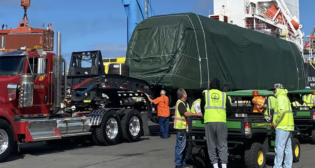
When bad things happen to good companies, and to good people
Written by William C. Vantuono, Editor-in-ChiefOf one thing you can be sure: There are more second acts in politics than there are second chances in public relations.
A case in point is one of the most respected railroaders of two generations—Ed Burkhardt, whose operating career at Chicago & North Western and Wisconsin Central, and skills at privatizing the freight operations of the former state-owned British Rail in creating the English Welsh & Scottish Railway, are, in the words of more than one of his peers, “legendary.” We have known and admired Ed Burkhardt for more years than most of today’s senior rail management has been in railroading, and the events following the accident at Lac-Mégantic on the Montreal, Maine & Atlantic have been extremely painful for us to observe.
Painful because we have both “been there”—close-up and at a distance—as practitioners of the public relations art that, while mostly an art, has elements of a specific science. We are adherents of media training for senior rail management because we know, all too well, what can and does go wrong when the world about them turns topsy-turvy in seemingly nanoseconds.
We both learned from how the makers of Tylenol turned a made-for-the media disaster into a positive outcome, and how, by contrast, Exxon, in the midst of an environmental calamity, turned an environmental disaster into a maelstrom of blunders. Closer to home, we have sought to guide rail management and rail labor in dealing with unfortunate events so as to achieve more positive outcomes—sometimes successfully and sometimes not, depending on the willingness of our superiors to accept counsel.
Bad things happen to good companies and to good people, and how they respond in the initial hours is crucial to how they are viewed down the road by the media, public, regulators, and lawmakers.
Ed’s unfortunate experience—one that sadly could cap and muddy a career of superior achievement—is worth dissecting for the lessons needed to be learned by those who will face similar circumstances, because no matter the commitment to safety of responsible management, accidents happen.
Our commentary is not intended to embarrass Ed, whose skin we know is thick enough to accept his experience for the learning experience that can and should be imparted.
The blunders, which could have been avoided, are many:
Rather than wait days to visit the scene of the Canadian disaster in the Quebec town of Lac–Mégantic, where tank cars filled with crude oil broke loose in a horrific outcome, he should have been on the scene, as the railroad’s most senior executive, within hours. Amtrak President Joe Boardman, for example, won widespread and continuing praise for flying immediately to a fatal Amtrak accident in Nevada in 2011. If the CEO cannot immediately go to the scene, another senior executive should be designated and authorized to represent the railroad and the CEO. (To be fair, MM&A President and CEO Bob Grindrod and other staff arrived on the scene immediately, but a disaster of this magnitude arguably calls for the immediate arrival of the most senior of officers.)
Upon his arrival in a French speaking Quebec town, Ed should have been prepared to speak French phrases of remorse—or been accompanied by a French speaking aide. President John F. Kennedy is still widely revered in Germany for speaking, “Ich bin ein Berliner” (I am a Berliner) in 1963, 22 months after the Soviet-supported East Germany erected the infamous Berlin Wall.
Instead, as widely reported by the media, Ed initially quipped—among grief-stricken townspeople—that he was concerned for his own safety, saying in front of electronic and print media representatives, “I hope I am not going to get shot. I’m not wearing a bullet-proof vest.” Those who know Ed as we do understood that as an attempt to inject a bit of levity into a terrible situation, but it was not a time for levity. Local people were terribly offended.
Compounding that malapropism, Ed was quoted as initially blaming the local fire department (“I think the fire department played a role in this”) and then placing the blame on the train’s engineer before an official investigation had even commenced. Rule one of communicating is not to speculate on causes or fault until those who are tasked by law with determining such things have had a chance to carry out their tasks.
This all prompted a local resident to tell the media, “If a team had come to see us and said, ‘Yes, we’re here for you and there was an accident, yes, there was human error, yes, this happened,’ it seems like that would have hurt less. I would have been able to get through that. But this is inconceivable. I can’t accept it.”
Media relations do not have to be adversarial. Most reporters are not out to “get” corporate or union executives. They are out to get a story and learn as many facts as are available.
For example, Jerry Davis, former President and CEO of Southern Pacific and later President and COO of Union Pacific, had a reputation as a “bear” on safety and received praise for it from industry and government officials as well as respect from the media. He observed on several occasions that railroading is not inherently dangerous, as many frequently say, but it is very unforgiving.
When incidents did occur, Jerry would get thoroughly briefed by his operating executives, and only when he had a complete understanding of what he had to deal with did he take calls from the media. His ability to affably provide solid, factual information gained him—and his railroad—fair media treatment.
SP suffered through a fatal runaway wreck in the winter of 1996 when a manifest freight got away from the crew and wrecked at 10,400 feet up on Tennessee Pass in the Rocky Mountains of Colorado. Two of the train’s three train crewmembers were killed. A news briefing was scheduled the next day at the headquarters of the White National Forest. The accident had ruptured five tankers loaded with sulfuric acid, and 50,000 gallons cascaded down the mountainside in the forest.
By the time of the briefing, the identities of the dead crewmen had been released by civil authorities and their families had been notified. That information mollified news representatives to some degree.
A particularly aggressive reporter asked if the Forest Service was concerned that SP might not “step up to its responsibilities” and pay for forest remediation. The Forest Service spokesman replied that, unfortunately, accidents involving SP had occurred over time, but SP always had accepted its responsibility before. He said he was absolutely certain SP would, in fact, pay to remediate damage caused by its wreck.
It would have been unseemly for the SP communications officer to kiss the Forest Service spokesman, but what could have turned bad became a non-issue thanks to decent relations between the railroad and the Forest Service.
We both recall from our days—although some decades ago—at the AAR how serious railroad accidents would prompt then Executive Vice President Dick Briggs to call an immediate meeting of senior staff, no matter the day or hour. The AAR’s experts in operations, safety, research, economics, legislative, legal, and public relations each would weigh in with short briefings limited to past experience, lessons learned, tutorials on rail operations, and suggestions for current action.
Briggs then would make assignments, with PR taking a lead in preparing fact-based news releases providing railroad safety data, current efforts at improving safety, an understanding of rail operations, an explanation of how such accidents are investigated, and a warning of how early speculation most often is found by trained federal investigators to be inaccurate. This would be backed up by more scholarly “white papers” with citations, and one-page summaries for distribution to lawmakers.
Fair and balanced reporting is an objective of the media, but the television, radio, internet, and print journalists—and, especially, the lawmakers and the public—are not mind readers.
Larry Kaufman held various senior public relations positions at the AAR, Burlington Northern, Southern Pacific, and Union Pacific between 1974 and 1996. He was a consultant to Norfolk Southern in strategic planning from 1996 to 1997, during the Conrail acquisition, and a consultant to CN in 1998, during the Illinois Central acquisition. Frank Wilner was AVP for Public Affairs at the AAR and recently retired as Director of Public Relations for the United Transportation Union. Both have extensive backgrounds in rail transportation-related journalism.



